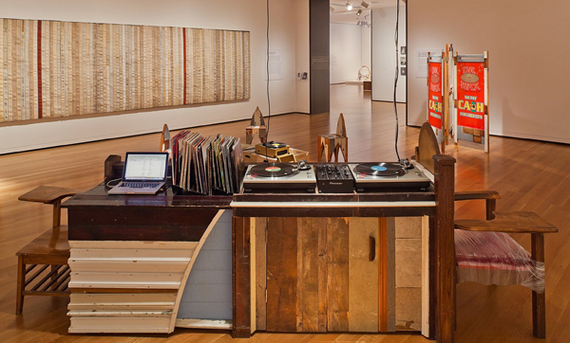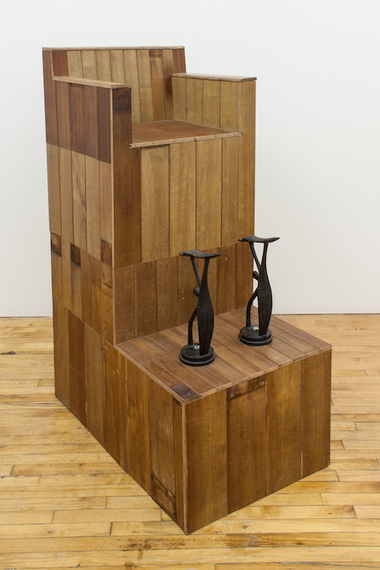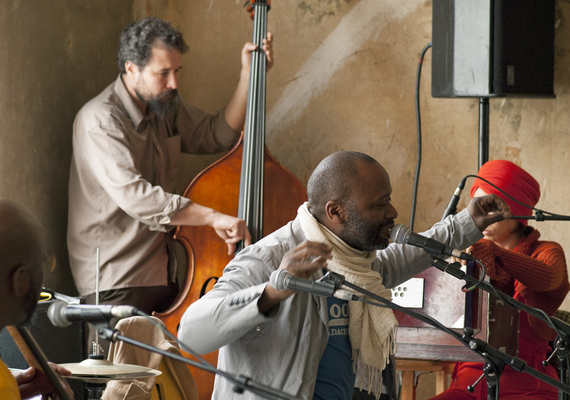
Theaster Gates and The Black Monks of Mississippi performing at The Huguenot House, Documenta 13, 2012, Photo by Young Sun Han, Image courtesy Kavi Gupta Gallery
Fourteen years ago when Theaster Gates sat behind a desk sifting through art proposals, an urban planner for Chicago's Transit Authority, he was learning about red tape. Knowing how the machinery ran fueled his desire to sculpt a city for its people not just for the traffic running through it.
At the time, he recalled, it was fun being an advocate for other artists, but given a grant recently to create subway art himself, he conspired to create something artful on Chicago's Red Line Terminal at 95th Street. The plan is to partner with a local public radio station for live community programming. "Real time, live, with guest DJs," he says, "There'll be just one object. The rest is imagining the most radical use of space possible as a result of it being a public program."
Creating art that's more than something to stare at or hang on walls, is to fulfill the imperative of living a poetic life. How does one place a price on that? Gates often brings up Joseph Beuys' theories of social sculpture to describe the need to serve the multiplicities of one's call in life.
Will the city fund this on an ongoing basis?
"I'm honored that the city would even consider a radio station as a work of art," said Gates, "since it's a stretch for them -- not receiving a monument. I applaud them for allowing me to think more expansively in not wanting a permanent object."
My first meeting with Theaster Gates was after a talk at the SCAD Museum of Art* -- I'd just arrived after a long delay, and listening to Gates play his Nina Simone tunes, and hearing his church banter, turned my sour mood sweet.
Gates uses music in his role of artist as shaman, infusing spirit into his teachings. "As I walk with the lord and ask him to be my art-dealer..." he jestingly sang, then sobered to a discussion of segregation, dispersion of community, the dissipation of cultures and the demise of beautiful buildings. On the lack of cultural arenas in poorer neighbourhoods, Gates lamented, "There was no option for togetherness."
In person, Gates' solemn demeanor belies his fiery-from-the-pulpit enthusiasm once he gets into his groove. At a dinner that night we enjoyed a little more sharing and southern hospitality with Gates and other artists, Dustin Yellin, Alfredo Jaar and Tim Rollins, all of whom were involved in socially engaged art practices. "There is value in shared proximity," Gates had said, and community is a springboard for creativity.
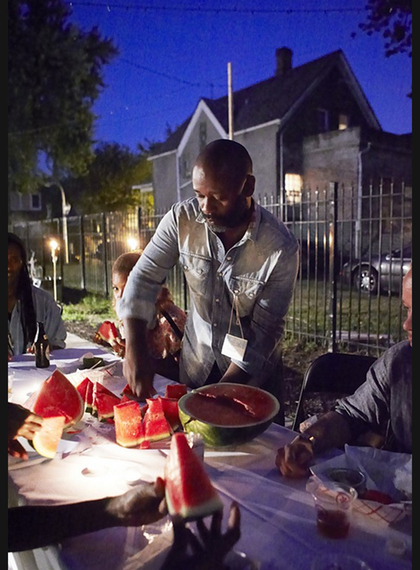
Theaster Gates building togetherness -- The Black Artists Retreat social -- 2013 photo: Sara Pooley. Courtesy of artist.
Speaking of togetherness, later, over long distance, I remarked how nice it was to sip a macchiato at an old European piazza, or dance the foxtrot holding hands with strangers on Bastille Day -- unlike in the car-clogged arteries of Manhattan where the lack of breathing space has led to a formation of virtual hubs, watering-holes, and shared workspaces like NeueHouse and community art spaces like Yellin's own Pioneer Works.
"The way we congregate and aggregate is different from the time of the great squares," Gates suggested, "I'm surprised at the number of people who work in cafés, who want to do individual work but also be nearer each other. Is there a way we can imagine new ways of public congregation that can happen more fluidly and organically? Whether it's in the Strand bookstore... it often happens around places of commerce."
Theaster (which means 'star of god'), was named after his father who tarred roofs, and his mother -- brought him up to make do with what he had. And so he did -- learning to shape it like clay. Becoming a potter was the first step in that journey.
Jumping ahead, many years later: "I just signed to White Cube, and my friends were like, 'Oh god, Theaster's sold to the devil,' " said Gates, who enjoys fostering a bit of tension, while aiming to leverage all economic possibilities to benefit his art, "Without that constant tension of different kinds, you thwart the possibility of a certain kind of greatness," he explains.
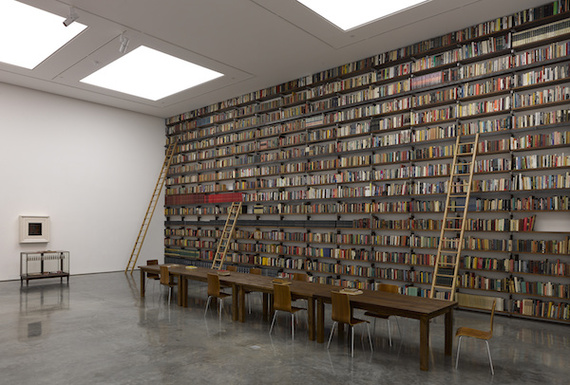
Theaster Gates, 'My Labor Is My Protest', South Galleries and 9x9x9, White Cube Bermondsey, © Theaster Gates, Photo: Ben Westoby, Courtesy White Cube and Johnson Publishing Company, LLC All rights reserved
In fact, White Cube generously partnered with Gates to recreate a library in their gallery, shipping over books given to him by the Johnson Publishing Company, the Chicago-based publishers of Ebony. When the London gallery pressed, You can build a library here, sure, but what are you gonna sell? Gates came up with a creative solution.
At the time, he was attempting to salvage a derelict, historic bank -- Gates is moved by the wabi sabi of time's ravages, its symbol of neglect and decaying memories. The once grand building synced with his desire to preserve cultural detritus, music, manners and vibes of communities rapidly devolving and disappearing. The lack of ownership or stake in one's own community begets apathy -- something Gates hoped to change. Not having the funds to pay for the building himself, he found marble wainscoting on the walls of the urinals, cut them into chunks, water-etched them, and sold them as bonds to collectors in Art Basel, Switzerland, the seat of world banking. He was then able to buy the building.
"I weaned more from the symbolic, leaned into the symbolic, looking for ways the bank might pay for itself," Gates lilted in waves like a poet-preacher.
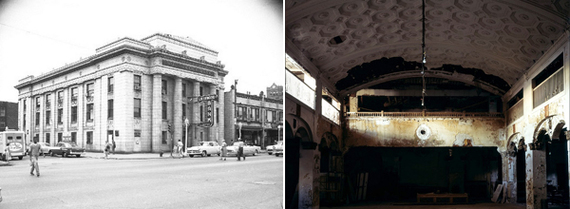
Southmoor Bank & Trust -source -Flickr-WayOutWardell and the Bank Vault Atrium when Gates took it over -- Courtesy of artist.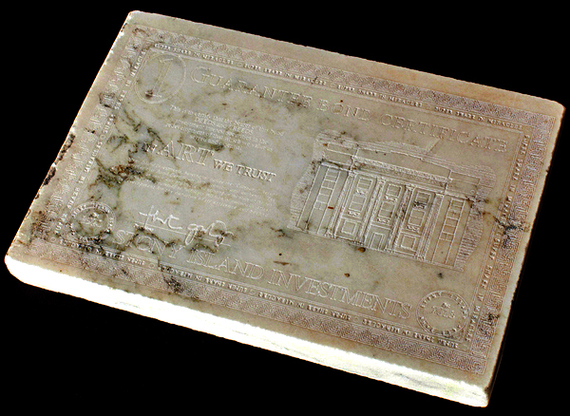
Theaster Gates, Bank Bond for Stony Island Bank, 2013, Marble, 6" x 8.75" x .75", Photo by Joseph Rynkiewicz, Image courtesy Kavi Gupta Gallery
While Gates admits the irony in this, and of shipping the Johnson library to London, and "having British wealth subsidize Black education," he concedes with an empathic practicality, "Artists, architects, designers and academics are asking themselves, how am I going to make a living? These objects are functioning at all these levels, and I would be unreasonable if I didn't understand that the creation of art included the production of art that lives in a market."
Theaster Gates, Shoe Shine for Bank Executive, 2013, part of an perfomative installation he used to shine shoes at art fairs. Photo by Joseph Rynkiewicz -- Image courtesy Kavi Gupta Gallery
View this video for a performance at the Shine King in Chicago with his band
"I have the willingness to think fully about where opportunities are, and where they live," said Gates. "If we imagine that the only right that we have is to make commodifiable objects, then we limit our practice and we limit the great potential for an understanding between collectors, curators and galleries."
Perhaps collectors should also shift their way of thinking such that collecting can go beyond self-gratification, focus on the more philanthropic? I suggest.
"Collectors can be smarter than we give them credit for," replied Gates.
One of his supporters, philanthropist Walter Evans, an avid collector of African American art, (Bill Cosby being another), began acquiring literature and rare books on the African American experience before it became vogue. The walls of Evans' house in Savannah are lined with fine and rare paintings by African American artists and his cabinets crammed with such treasures as Malcolm X's letters from Mecca.
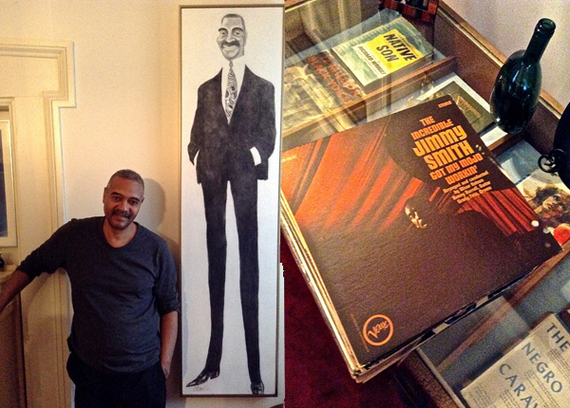
The collector Walter O. Evans, standing by a portrait, and some tunes from Evans' record collection. Photo: K.Lala, 2014
"Walter has been the great new gift of my life -- and just his passion for collecting -- he is an open spirit, a super cool dude."
I tell Gates that in a study I read recently, over 90% of philanthropy went to preserve intellectual thought, religion, human health & culture, and maybe 3% went to the environment -- so we're not preserving our physical space.
"I sometimes am challenged to imagine where the timbre of art should be. Should it be about objects that point to this current moment, or how objects are related to ideas of this current moment? I want to spend my time between the creation of ideas and the creation of things."
I ask what role he thinks museums should play in preserving cultural artifacts, because so many view it as a static task -- and might his cultural archives like the Dorchester projects on Chicago's south side, handle this differently?
"Museums should expect more from their objects than just history. The challenge to museums, when a thing is one thousand years old, is that they keep talking about the thing from the perspective of its age, instead of trying to find ways to reload it with new insight."
"An African fetish, used in powerful ways often needs to be coupled with new fetishes loaded with power so people have a sense of history as well as the power of the fetish.
Contemporary art functions as that fetish, but instead of having spiritual power we give it only economic, or certain kinds of cultural power."
On the subject of rebuilding communities, he says, "I am a cog in the wheel..." Gates sees himself more as a catalyst and part of a greater cultural and philosophical movement reshaping the world. "It's an autonomous work of art, with room for dynamic -- an art practice that's insistent upon the integration of other ideas."
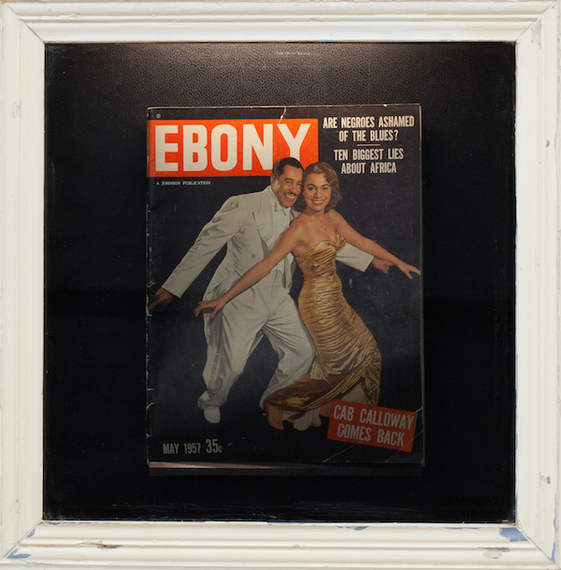
Theaster Gates Ebony Vitrine (placeholder) Detail, wood, glass, light, Ebony Magazine and black felt, 2012, Photo by Joseph Rynkiewicz - Image courtesy Kavi Gupta Gallery
We talk about artist Steve McQueen's recent Oscar for Twelve Years a Slave, "He was willing to not only use the art world form," says Gates, "but also take on the popular form. I think he's one of the great geniuses of our time -- to recognize the stakes and the particular form -- and win..."
As an artist, McQueen works with many different influences across genres -- but does American race and cultural legacies place limitations on him? "When I think of a work of art, I would be lying if I wasn't thinking of race, if I wasn't thinking of class, my history of god - all of those things come to bear on the creation of a work of art," replies Gates.
"I don't have the gift of pure thought, I have the gift of impure thought, those impure thoughts, they come from everywhere, and they are my imagination."
As for future plans, he is considering making a brick-making kiln. "I'm seriously pursuing a brick manufacturing company -- the hope is that I'm a planner -- and the brick is my principle module. I'm super excited that the idea of creating a corporation will be like the archives, exploring the deep potential of a big apparatus," says Gates with an infectious faith that has the power of gospel. The brick is the symbolic unit of Gates' imagination, the DNA for endless possibilities -- and will they have a Theaster Gates logo?
"Sure," he muses, "More, I think that the brick itself is the creation of this space...a demonstration of dreams in lots of different forms.
It's a part of the rubric of my imagination. It's going to benefit people and generate new ideas. I wouldn't take it so seriously if it couldn't do all those things implicitly. Of course it's going to make money. But it's a brick, a module unit is going to cost $3 -- it's not a $400,000 object.
Brick and clay have the potential to be... well, they only have the limitations of the maker."
Creating Heat -- The Artist as Catalyst: Theaster Gates at TEDx
***
For further information:
*The Jacob and Gwendolyn Lawrence Foundation lecture, was titled "An Analog but Very Important Conversation."
Theaster Gates website
Kavi Gupta Gallery Berlin/Chicago
White Cube Gallery
Theaster Gates -- Rebuild Foundation
Text & Interviews: www.KisaLala.com
Instagram: kisa_lala

